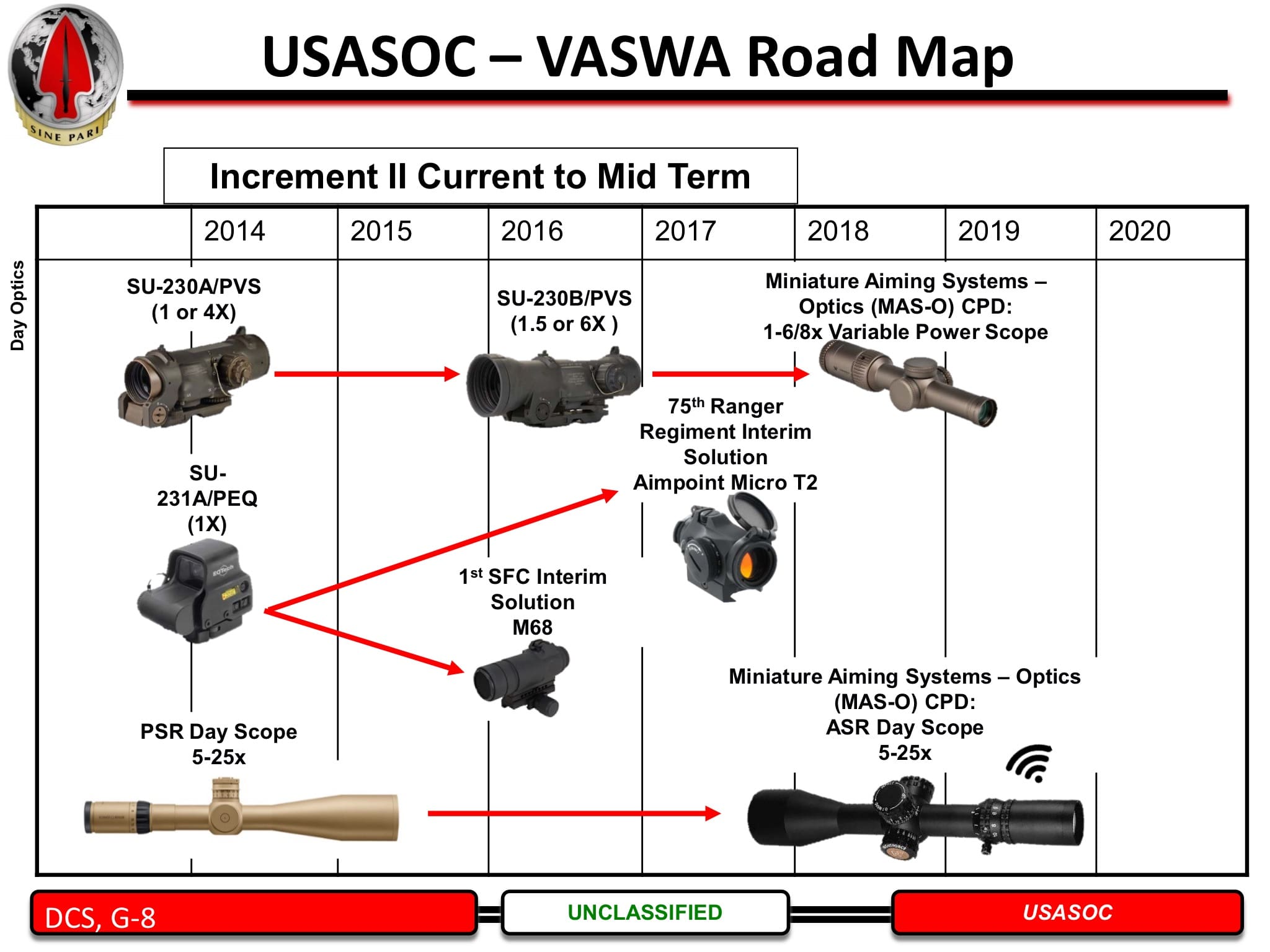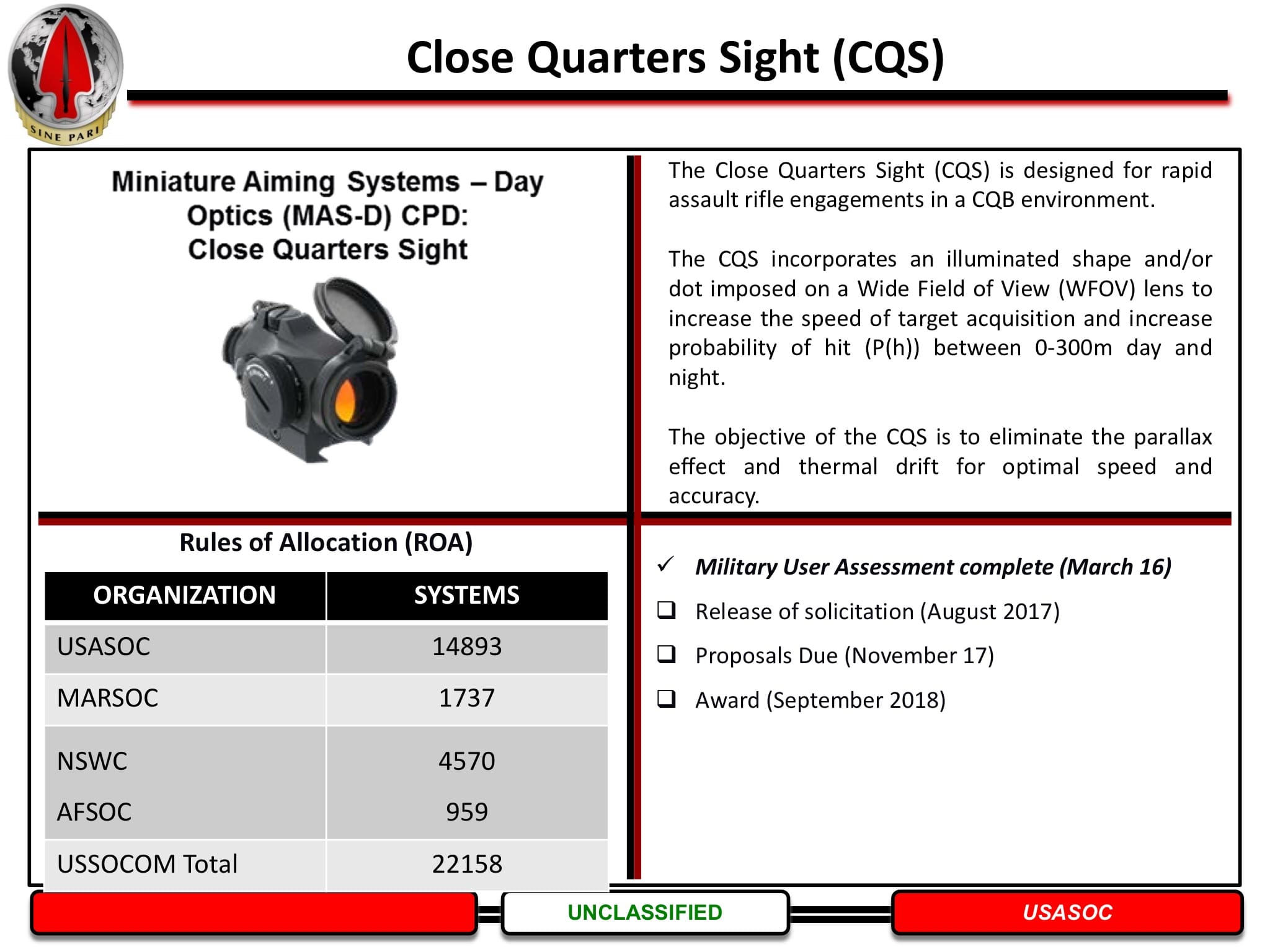The Naval Surface Warfare Center, Crane Division, which manages small arms development for USSOCOM, has issued a presolicitation, informing industry that it intends to issue a solicitation contract for a full and open competition for an anticipated Firm Fixed Price Indefinite Delivery Indefinite Quantity (IDIQ) contract that will cover a five year ordering period with five (5) additional one (1) year options that may be exercised at the Governments convenience. When you see the minimum and maximum for the IDIQ, your eyebrows will raise a little, but it will make sense.
The anticipated requirement is for a Miniature Aiming System – Day Optics (MAS-D) Squad – Close Quarters Sight (CQS) and Clip-On Magnifier (CM). The sights will be used on both compact and assault rifles. The anticipated contract minimum quantity is thirty (30) units OR $36,000 and the anticipated contract maximum quantity is thirty-nine thousand three hundred units (39,300) OR $47,160,000. These numbers give the command a great deal of flexibility, allowing them to select more than one contract awardee. Additionally, there is room for other organizations to purchase from this contract.
This slide comes from COL Samuel Ashley’s (USASOC G8) briefing at last month’s NDIA Armaments Symposium. Many know that USASOC divested itself from the use of EOTech Holographic Weapon Sights due to their thermal shift issue. What many don’t know is what they replaced them with as an interim solution. The 75th Ranger Regiment had an immediate need and a shoot off of Commercial Off The Shelf red dot sights was conducted at Ft Bragg, NC. The sights evaluated included the EOTech as a baseline, Aimpoint T2, Leupold LCO and Trijicon MCO. I am told that the EOTech performed very well but that it was not a candidate for selection due to its thermal shift problems. I am also told that the user evaluation preferred the Leupold LCO. However, in a second phase of the evaulation conducted at Crane, the LCO had some reliability challenges, so ultimately, the Rangers got the Aimpoint T2. Interestingly, 1st Special Forces Command (Airborne)(Provisional) chose to field the Army’s service common M68 optic, also by Aimpoint. The use of service common equipment saves the command’s MFP-11 Dollars for other capabilities.
Below is another slide from that same briefing that shows, in generalities, what USSOCOM expects from a Close Quarters Sight and how many they want to buy.
The anticipated timeframe for the release of the solicitation is expected to be in the Fall of 2017. For full details, visit www.fbo.gov.




Kinda cool seeing the M68 still rocking in 2017. That’s what, 25 years of service?
Nah, same designation but now it’s CompM4.
Ah,thanks for the clarification.
Geesh…can’t they just say, “Aimpoint T2” and be done with it? What a ridiculous waste of time and money.
There are some advantages to the bigger tube and the AA battery size of the Comp M4.
So SSD, is the desired end state to have 1x optic in the 1-6x or 1-8x range to replace both the ELCAN and T2?
I wonder what Trijicon MCO is. Maybe a typo of MRO? Wonder how it did.
I can actually see where they (Aimpoint) are losing some market opportunity. Not only are people who were running Elcan’s switching to Vortex’s, but so are T1/T2 users.
Two things Aimpoint needs to come out with:
1) Nano for handguns; create quick detach feature.
2) LPVO 1-6; best in class battery life and weight.
Why does the slide show a Vortex for the 1-6?
It’s in limited use currently.
Any info on unit and how they’ve been fielded? I’m curious how they hold up compared to other variable optics like Leopold, Schmidt and Bender, etc.
It’s very popular among a couple of jsoc units. That says something.
There were couple of JSOC pics available in public with Vortex 1-6x mounted on HK416’s.